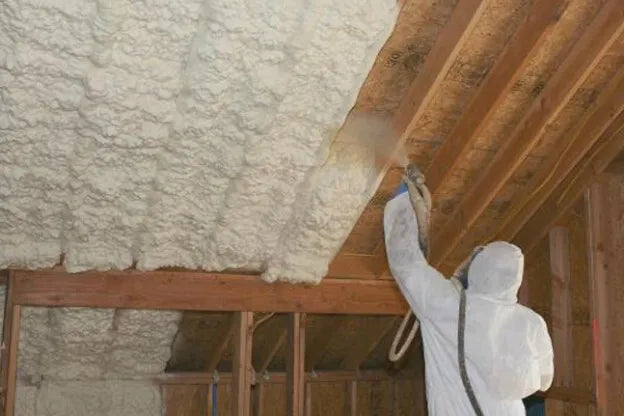Is Closed Cell Foam Flammable? Explore Safety Facts 2024
Building materials like closed-cell foam's ability to catch fire is vital, especially for homes and structures. VB Insulation is at the forefront, teaching users about product safety and performance. This in-depth guide will cover fire resistance, safety grades, and rules for using closed-cell foam. We aim to empower you to choose wisely.
Is closed-cell foam fire-safe? What should homeowners and builders understand about its safety? Let's explore the facts behind closed-cell foam and its fire behavior. This exploration will provide the essential details for safe and compliant construction work.
Key Takeaways
- Closed-cell foam is usually better at resisting fire than open-cell foam. However, it can still burn.
- Flammability in closed cell foam changes due to aspects like what it's made of, how dense it is, and if it has fire retardants.
- This foam has to follow strict fire safety rules and building codes to keep people safe.
- Picking the right closed cell foam and installing it correctly, with fire barriers, reduces the fire hazard.
- Companies and authorities work together to ensure their closed cell foam meets fire safety standards.
Understanding Closed Cell Foam
Closed-cell foam is a type of rigid, high-density insulation commonly used in construction. It is made of polyurethane or polyisocyanurate (polyiso).
The foam's closed-cell structure means its cells are sealed, preventing air or water from passing through. This makes it excellent insulation for managing heat and moisture in buildings.

Composition and Structure
The sealed cells in closed-cell foam stop air and water from moving, making it very good at insulating against heat and moisture. It is denser and more rigid than open-cell foam, which helps it provide insulation and support in buildings.
Applications in Construction and Insulation
Closed-cell foam is used in walls, roofs, and foundations. It manages heat and moisture well, making it a top pick for many building and insulation projects. VB Insulation has many closed-cell foam products, like the V600 closed-cell spray foam.
Is Closed Cell Foam Flammable?
Understanding closed-cell foam's flammability is crucial for VB Insulation. It affects fire safety and meeting building codes. Closed-cell foam is harder to ignite than open-cell foam, yet still flammable. Its flammability depends on its composition, density, and the use of flame retardants.
Extensive fire tests are done to check how fast the foam burns and how much heat and smoke it releases. These results help classify its fire safety and whether it fits building codes. VB Insulation ensures that closed-cell foam products are very safe by exceeding fire resistance and safety standards.
Fire Resistance and Safety Ratings
Closed-cell foam meets strict fire safety rules and building codes. It must perform well in flame spread, smoke development, and general fire resistance. VB Insulation ensures that closed-cell foam follows these guidelines. This keeps buildings safe for everyone and stops fires from spreading.
Building Codes and Regulations
The fire resistance of closed cell foam is crucial for following construction laws and safety norms. VB Insulation must stick to strict standards from groups like the International Building Code (IBC) and the National Fire Protection Association (NFPA). These standards set the bar for flame spread, heat release, and smoke development. Closed cell foam must meet these requirements to be fire-resistant and safe for homes, businesses, or factories.
Flame Spread and Smoke Development
Fire tests check how well closed-cell foam resists flames and smoke. They see if the material stops fire from starting, slows flames, and reduces harmful smoke. VB Insulation makes sure its foam passes these tests. This means its foam keeps buildings warm and safe without risking people's lives or property.
Factors Affecting Flammability
Closed-cell foam, a top pick for fire-resistant insulation, can catch fire under certain conditions. Understanding these conditions is crucial. This knowledge helps ensure closed cell foam meets safety guidelines, which is vital, especially when following fire codes and keeping buildings safe.
Foam Density and Composition
The amount of foam and what it's made of affects how it reacts to fire. Foams with a higher density often resist fire better. This is because they have fewer areas where fires can burn, and they slow down a fire. The materials used to make the foam, like polymers and fire retardants, also change how well it burns.
Ignition Sources and Temperatures
How flammable the foam is depends on what makes it catch fire and how hot it gets. Things like a spark from electricity, an open flame, or very hot work can start a fire. It's very important for the foam not to easily catch fire. This stops flames from spreading quickly, keeping people safe and limiting fire damage.
Knowing why foam burns helps people choose and use it safely. VB Insulation is dedicated to offering safe, fire-resistant foam insulation that's up to code. Our goal is to protect our customers with quality, fire-resistant insulation solutions.
Fire Retardant Treatments and Alternatives
At VB Insulation, safety is our top priority. We know how crucial it is to ensure that insulation materials are fire-safe. That's why we boost the fire resistance of our closed-cell foam products by adding special flame retardant additives to the foam mix. These additives, like halogen or phosphorus compounds, stop or slow down fires. They make our foam much safer, improving its fire rating and thermal properties.
But that's not all. We also use thermal barriers to add another protective layer. These can be materials like gypsum board or intumescent coatings. They help block heat and lessen the spread of flames and the development of smoke. Such barriers are key for following fire codes. They ensure a building is safe from fire and uses energy well.
Non-Combustible Insulation Materials
For places where top-grade fire safety is a must, VB Insulation offers non-combustible insulation materials. These are great alternatives to our closed cell foam. They include mineral wool and fiberglass. These materials naturally resist fire and don't help it spread. They're perfect for projects needing the best insulation safety and full fire code compliance.
Conclusion
The flammability of closed cell foam is crucial for those who build homes or work on them. It's often better at resisting fire than open cell foam. Still, it can catch fire and burn. So, its fire safety needs checking. This means looking at what it's made of, how dense it is, and if it has any special fire-resistant things in it. By knowing these things, we can pick wisely and keep our homes and the people in them safe.
VB Insulation works hard to offer fire-resistant insulation that complies with building rules. This way, our clients trust in the safety and quality of the materials we provide. We take the safety of our insulation seriously. Our products meet the highest fire safety standards, and they help keep your building's temperature and moisture under control. They also put safety first for those living in or using the building.
We look into foam that doesn't burn, keeping in mind the newest tests and rules on fire. VB Insulation aims to teach why choosing the right insulation matters. It's about both how well it works and keeping everyone safe from fire. Working together, we can build safer homes, use less energy, and last a long time.
FAQ
Is closed cell foam flammable?
Yes, closed-cell foam can burn, but it burns slower than open-cell foam. Its ability to resist fire depends on what it's made of, how dense it is, and if it has fire-retardant chemicals.
What are the fire resistance properties of closed cell foam?
Closed-cell foam often needs to pass tough fire safety tests. It must perform well in terms of how it burns, how much smoke it makes, and how it fights fires in general. Makers ensure their foam meets the needed fire safety for different uses in buildings.
How are the fire safety ratings of closed cell foam determined?
Tests that examine how flames spread, how much heat they release, and the smoke they produce determine their fire safety rating. These results help us determine whether the foam is safe for building codes and people in the building.
What factors affect the flammability of closed cell foam?
Closed-cell foam's burn risk is tied to its density, what it's made of, and any added fire blocker. More tightly packed foams are harder to burn. The materials inside also matter a lot for fire safety.
Are there any fire-retardant treatments or alternatives to closed cell foam?
Yes, extra fire blockers can be mixed into closed-cell foam to improve its burn safety. Adding materials like gypsum board on top can also help. In places where extreme fire safety is needed, non-burnable materials like mineral wool or fiberglass might be better choices.




